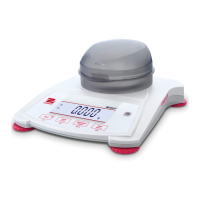What to do if OHAUS Scales display 'CAL E'?
- CCorey AustinSep 9, 2025
If your OHAUS Scales are showing 'CAL E', it means the calibration process has failed. Ensure you carefully follow the calibration process.
What to do if OHAUS Scales display 'CAL E'?
If your OHAUS Scales are showing 'CAL E', it means the calibration process has failed. Ensure you carefully follow the calibration process.
Why OHAUS SPX621 Scales cannot calibrate?
If your OHAUS Scales cannot calibrate, it might be because the security switch is in a locked position.
How to fix OHAUS SPX621 that will not turn on?
If your OHAUS Scales won't turn on, the issue might be due to a lack of power. Check the power supply to ensure it is properly connected and functioning.
What to do if OHAUS SPX621 Scales show 'Err 8.3'?
If your OHAUS Scales display the error message 'Err 8.3', it means the weight on the scale exceeds its rated capacity. To resolve this, remove the excess weight from the scale.
Why OHAUS SPX621 show Err 8.3?
The Err 8.3 error on your OHAUS Scales indicates an overload, meaning the weight on the scale exceeds its rated capacity.
What does 'USB.Err' mean on OHAUS SPX621?
If your OHAUS Scales display 'USB.Err', it means that the menu or app file cannot be found in the U-disk. Check the U-disk to ensure it contains the required files.
What does 'ref.err' mean on OHAUS SPX621 Scales?
If your OHAUS Scales display 'ref.err', it means there is a parts counting or percentage error because the sample weight is less than 1d. Use a sample weight that is 1d or greater.
What does 'Lo.ref' mean on OHAUS Scales?
If your OHAUS Scales display 'Lo.ref', it means the Percent Reference weight or APW is too low for accurate results. Increase the reference weight or APW.
What does 'Err 8.4' mean on OHAUS Scales?
If your OHAUS Scales display 'Err 8.4', this indicates an underload condition, meaning the pan is removed. Make sure the pan is properly in place.
Why OHAUS SPX621 Scales show Err 8.6?
The Err 8.6 error on OHAUS Scales indicates that the displayed value exceeds 999999, which is possible in Totalization mode.
Outlines essential safety precautions for installing, connecting, and operating the balance.
Instructions for connecting the AC adapter and installing batteries for power.
Emphasizes the need for initial calibration after installation or relocation for accuracy.
Detailed procedure for performing a span calibration, including pre-requisites.
Describes how to use the default weighing mode to measure sample weight.
Explains how to use the counting mode to count items based on reference weight.
Details how to measure sample weight as a percentage of a reference weight.
How to compare weights against a target range using positive, negative, or zero checks.
Steps for setting up and performing check weighing with low, high, and accept limits.
Describes how to store and sum multiple weight measurements.
Explains how to use Peak Hold and Display Hold to capture stable weight values.
Details on how to access and perform Span and Linearity calibrations.
A table listing common symptoms, possible causes, and remedies for balance issues.
Outlines essential safety precautions for installing, connecting, and operating the balance.
Instructions for connecting the AC adapter and installing batteries for power.
Emphasizes the need for initial calibration after installation or relocation for accuracy.
Detailed procedure for performing a span calibration, including pre-requisites.
Describes how to use the default weighing mode to measure sample weight.
Explains how to use the counting mode to count items based on reference weight.
Details how to measure sample weight as a percentage of a reference weight.
How to compare weights against a target range using positive, negative, or zero checks.
Steps for setting up and performing check weighing with low, high, and accept limits.
Describes how to store and sum multiple weight measurements.
Explains how to use Peak Hold and Display Hold to capture stable weight values.
Details on how to access and perform Span and Linearity calibrations.
A table listing common symptoms, possible causes, and remedies for balance issues.
| Capacity | 620 g |
|---|---|
| Readability | 0.1 g |
| Pan Size | 120 mm |
| Calibration | External |
| Display Type | LCD |
| Linearity | ±0.2 g |
| Repeatability | 0.1 g |
| Stabilization Time | 2 seconds |
| Power Supply | AC Adapter |
| Operating Temperature Range | 0 to 40 °C |
| Units of Measurement | g, lb, oz |











